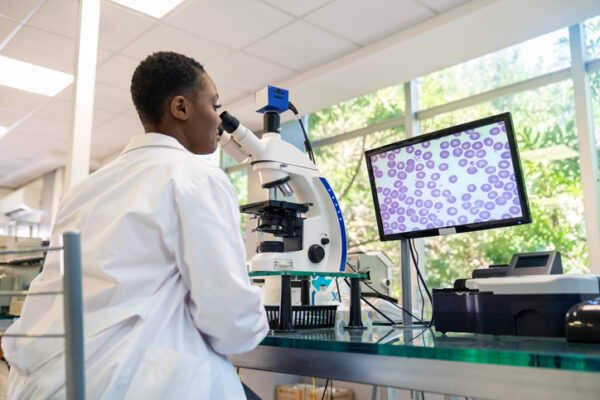
The field of pathology, an integral part of the healthcare system, is approaching a crisis point, as constant and growing demand for pathology services threatens to outweigh the number of pathologists. The supply-demand imbalance is driven by increased healthcare needs, a global pathologist shortage, and the expanding complexity of medical diagnostics—all of which can impact healthcare delivery and patient outcomes. On average, there are roughly 14 pathologists per one million people worldwide, with larger disparities seen in developing countries. This workforce shortage is happening as cancer rates continue to grow. In 2022, there were almost 20 million new cases and 9.7 million cancer-related deaths worldwide. By 2040, the number of new cancer cases per year is expected to rise to 29.9 million and the number of cancer-related deaths to 15.3 million.
A cancer misdiagnosis, or a delay in treatment time for cancer patients, can be the difference between life and death. While today’s typical biopsy results take an average of one to two weeks, the rising demand of cancer biopsies and decreasing supply of pathologists is creating an impending tipping point. However, there is a light at the end of the tunnel, and that light is artificial intelligence (AI).
Digital transformation: Setting laboratories up for success
The healthcare industry has rapidly embraced digital transformation. In fact, nearly 90% of health system executives report that digital transformation is a high or top priority for their organizations. AI is a critical component of digital transformation, and one that is already being embraced widely across hospital systems. For example, radiology departments, which are also grappling with their own surge in patient demand, use AI-enabled solutions to help streamline computed tomography (CT) workflows and maximize image quality. This includes everything from using AI to ensure the patient is in the right position for the exam, to using it to reconstruct images, reduce radiation doses, and improve image quality.
Undoubtedly, the power of AI can extend to laboratories as well, which can use AI to alleviate the supply and demand crisis, and enhance efficiency, accuracy, and speed in lab diagnostics. Laboratories can leverage AI to scan pathology slides and analyze them with advanced algorithms to identify different tissue types, detect cancerous cells, and even grade the severity of the cancer. This process mimics a pathologist’s diagnostic approach but adds an extra layer of precision. It not only helps reduce diagnostic errors by flagging potential issues, but also provides pathologists with the opportunity to review and correct any discrepancies before finalizing a diagnosis — a necessary step.
Of note, pathologists themselves are leaning into AI. In a survey from 2019 — when AI was still in its infancy — pathologists seemed to already see the value in AI. With most pathologists open to — or even excited about — the prospect of leveraging AI, it seems those who are resistant could risk falling behind or being replaced by pathologists that do use AI in practice. Of note, with pathologists eager to adopt AI and the industry in need of its benefits, now is the ideal time to strategize how AI can be integrated into pathology. However, to fully capitalize on its potential, laboratories must ensure they understand how to use AI effectively. Without this understanding, there’s a risk of undermining the technology’s benefits and potentially harming the industry as a whole.
Ensuring pathology AI innovation without cannibalization

The Human Algorithm: What AI Can’t Replace in Pharma Engagement
At a time when AI is reshaping pharma, Reverba Global CEO Cheryl Lubbert explained in an interview why empathy, context, and ethics still require a human touch.
In the realm of pathology, AI should be used as a security net — another layer of validation — not a replacement for human expertise. If not used correctly, AI can create a cycle of mediocrity that can ultimately harm the entire industry. That cycle could look something like this:
- Skill erosion – If pathologists rely too heavily on AI they risk losing their diagnostic skills, undermining their ability to interpret complex cases without technological assistance.
- Outdated data – For AI to remain effective, it needs to be regularly updated with new data. If pathologists lose basic skillsets, that means they are no longer updating AI systems with the latest research and real-world data, perpetuating outdated or inaccurate information and leading to poorer patient outcomes.
- Cannibalization – If AI is trained on its own outdated outputs, a feedback loop could form that causes the technology to essentially “eat itself” by making decisions based on repetitive or flawed data, further diminishing its reliability over time.
That is why human oversight is irreplaceable. Pathologists bring contextual knowledge, intuition, and critical thinking that AI currently cannot replicate, particularly when it comes to unique or rare cases that fall outside standard patterns. By instead giving pathologists AI systems and tools to validate test results and identify or correct misdiagnosis, it’s creating a digital safety net for an industry responsible for making life-or-death diagnoses accurately and effectively. That type of support is invaluable. The beauty of AI lies in its ability to complement pathologists’ efforts, providing reassurance that they are achieving higher levels of diagnostic precision and efficiency.
This increased precision and efficiency frees up pathologists’ time, allowing them to focus on research and advanced problem-solving — activities that, in turn, contribute to the ongoing improvement and refinement of the AI algorithms. As a result, we shift from a cycle of mediocrity to a cycle of excellence, for every patient, everywhere. Ultimately, by leveraging AI’s capabilities in data analysis and adaptive learning, laboratories can elevate diagnostic standards, improve patient care, and navigate the complexities of modern healthcare with greater confidence and productivity.
Photo: alvarez, Getty Images
Joseph Mossel is the CEO of Ibex Medical Analytics. His career in the tech industry spans more than 20 years, starting off in software development and product management followed with leadership positions in startups, large multinational corporations and non-profits. Joseph has led products from inception all the way to maturity as multi-million-dollar businesses. He holds a MSc in computer science from Tel Aviv University, and a MSc in environmental science from VU Amsterdam.
This post appears through the MedCity Influencers program. Anyone can publish their perspective on business and innovation in healthcare on MedCity News through MedCity Influencers. Click here to find out how.









